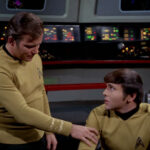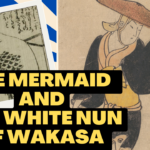
The Struggle to become Lord Elrond
By Durrilion
It took a lot of time to gather all the components of what would eventually be my version of Lord Elrond. I needed the pattern, fabric, thread, paint, and lots of patience!
With my awesome pattern in hand I went to work on the first layer. My fabric choice for this one was a medium weight upholstery cotton brocade in a light grey. Why this one? I loved the pattern, with its floral vine work weaving across the fabric, changing color as the light hit it from different angles. Plus it was a nod to my Amtgard days when I and that small band of Tolkien Elves wore grey silken robes, and tried to show the rest of the group what role playing really could be. What follows is a series of photos showing my progress, mistakes, and the end results of several months figuratively chained to my sewing machine.


The main body of the coat (as I called it to differentiate between them and the robe), was very easy. It was just a couple of straight lines. The collar was a bit tricky, but I made it work. Curved seams have always been difficult. Fortunately I learned a few tricks that made it easier.



With the ironed seam, the collar lies flat and looks amazing. Also it helps it stand up without the bulk of interfacing. That however did not help me stitch down the raw edge on the inside of the collar. In the next picture we can see where it got really bulky and just would not lie flat. Live and learn as the old saying goes.

I ran into a problem with the sleeve seams. I forgot how tight the wrist was. This made it impossible to run the seams through my machine. Thankfully I know how to hand sew. I think I was about halfway through the first side of the first seam, when I realized just how much hand sewing I had to do.

Finally I had a finished, well mostly, garment. I had yet to finish the wrists, or attach the buttons. In the sunlight, the pattern stands out beautifully. This is why I chose this fabric.


Shortly after the previous photos were taken, I finished the cuffs, and added the buttons. That part was also frustrating, as we’ll soon see.
Once my struggles were done with the under coat, I set upon the overcoat. My original plan had been to lean more toward the blue side. However this upholestry brocade jumped out at me and I knew at once I had to use it.
This fabric however, was quite the challenge. Working with a synthetic was more difficult, especially since it had ‘silver’ woven into it for the brocade. Ultimately it fell into place, and I added the lining material – a lightweight cotton in a co-ordinating color.
The buttons and button loops were still difficult to place. I made a mistake that cost me time, and a small amount of materials. The end result came out well though. As an experiment, I melted the ends of the loops to prevent fraying. Since the ribbon was a synthetic it worked. As we can see in the photo some of the loops did get a bit singed. Fortunately that part will never be seen again.

For extra security, and to keep the loops facing the proper direction, I had to hand sew them once they were stitched into the garment’s seams.


After stitching on the first loop, I double checked it to be sure. It turns out I had made them too long. So I had to shorten them. Good thing I only attached one, and that I double checked it.
I have no idea how anyone can use a machine to stitch on buttons, especially shank buttons. So I went back to handsewing, about 10 buttons total between the two layers. After a while it got easier, monotonous, but easier.

Once all the loops and buttons were on, I re-checked the fit. It’s not perfect, but it will certainly do the trick. The only downside that I’ve noticed is trying to fit the buttons through the silky ribbon while wearing it. Neither the buttons nor the loops want to co-operate.
Here are the photos of loop attachment for the second layer. This is where I really screwed up. At first everything looks great. Then, after a closer look, or in my case, when trying to pin the lining to the outerlayer, one quickly sees that the loops will in fact be trapped inside the seam. Grrrrr. It took some work, but eventually I sorted out the problem.
What was the difference that caused my error? The difference between this layer and the first one is the lining. The first one had no lining, so flipping the loops was easy. The second layer’s lining posed an unaccounted for challenge. I had to re-do the loop placement.


There is a pitfall for anyone using patterned fabrics. Make sure your pattern pieces are place correctly or you’ll end up with two pieces going the same way. Fortunately I had enough scrap fabric to fix this error. The patterned fabric reverses colors on the other side, so just flipping the ‘wrong’ piece was not an option. I’ve been called ‘crazy’, ‘anally-retentive’, and a few other things, but when it comes to my projects I have a certain vision, and I need to do everything in such a way as to bring that vision to life.
Despite all my pinning, and I pinned a lot, I had an issue with the fabric bunching up. Grrrrrrr.
Then just as mysteriously, it worked itself out, and everything went smoothly. I have no idea what happened, or would tell you, honestly.
It looks like a giant train wreck, but trust me there was no seam ripping or muttering of naughty bad words. What is shown in this photo is me stitching down the raw edge of the sleeve seam for the second layer. All the bunching is the body of the garment twisting as I work the fabric through. After realizing how tight the cuffs were on the grey layer, I made the cuffs on the second layer much wider by adding a vaguely leaf shaped flair to the last quarter of the sleeve. Also I left that part of the sleeve open to resemble sleeves seen on some of Elves in the movies.
See, the seam came out pretty well. This is the inside view of the flat-felled seam.
When I was working on the lining, I suddenly had a tension problem. I have no idea what happened, but it persisted for a while. Eventually it stopped, but it drove me crazy because I had to keep ripping out the messed up stitches. If you look at the left hand side of the photo, you can see a darker and thicker line, that is all the bunched up thread that had to be ripped out, I think three or four times before it suddenly decided to co-operate. I may have also changed to a new needle as well. I remember a friend telling me about her experiences and that for some reason a new needle seemed to solve it.
With both the outer layer, and the lining done, I had to put them together. Once again the pins come into play. If you look closely at the next two photos you can see where I realized the mistake with the loops.
I am still trying to figure out those loops in this next shot, other wise everything looks great so far.
Here’s a picture of the outer layer, without the lining. Overall, this is my favorite layer. The lighting in the house does not do it justice. It’s a light sea-foam green/turquoise (depending on whom one speaks to) with metallic silver. In a more natural light it is absolutely gorgeous! Bonus, I got it for 50% off at Joann’s! I love a good sale.
Once both coats were done, I focused on the belt. For this piece I used a white cotton sateen. One side is slightly shiny giving it an almost satin like appearance. In the next photo, the white background is actually the belt. The ribbon was chosen because of the star pattern. I felt it tied in with the star in the center of Durrilion’s heraldry. While the finished strips (one for either end of the belt) were machine stitched in place, I did have to hand sew the loops for proper placement.
Once it was done, I had to test the lacing. I used the remainder of the ribbon for this step. There were several reasons for this: 1, I already had the ribbon, 2, I really loved the star pattern, even though it is so small no one really notices it. Well I hope they don’t while I’m wearing it, or they should buy me dinner, or a drink at least.
The belt construction went so smoothly. In fact it went too smoothly. It turns out the fabric was not able to hold its shape. I did not account for buckling, so I had to deal with a scrunched up belt the whole day. I will have to add an interfacing layer to prevent that in the future. This resulted in the streamer looking as if it were magically floating at my waist, rather than descending from the belt.
I modified the original belt pattern to accommodate a design element from my Amtgard days. We added a streamer to the belt with our individual heraldry on the end. This streamer was a nightmare. My first attempt did not go well. To add detail to the plain fabric I decided to couch silver thread onto it. Great idea, but because I didn’t use a stabilizing fabric backing, I ended up with lots of puckered fabric.
I tried ironing it, but there was very little improvement. In the end I had to apply an interfacing layer after the fact. While that did help with the puckering, it wasn’t perfectly smooth. In future I will add the stabilizer before I do any embroidery.
Between painting and appliqueing the heraldry (slightly off center, which created a top stitching issue) and couching down the silver thread for the detailing, I’m surprised there was still time for the robe. Since the robe was a major nightmare, here are some work in progress shots of the heraldry. The painting of it went well, but my first attempt at decorating the upper portion was an epic failure. In the end I had to cut the heraldry off, and restitch it to another piece of fabric. For the heraldry I just used a basic acrylic craft paint. It looked good, but something was missing. I added a pearlized medium (thinned with water) as an overwash. That added some Elven magic.

The robe… it took almost a week, and a friend’s french curves to work out an appropriately Elven look for the couched design. The embroidery took almost a month. Between puckered fabric, tangling thread, and major frustration, I seriously debated if I wanted to do this at all.
How I didn’t pull out my hair, or commit a felony I don’t know. In the end the embroidery work came out very well. There were some other issues, but that’s another story.
The robe’s fabric, also a synthetic, was the only choice in the right color, but was extremely bland otherwise. Looking at the photos, it’s easy to see why I became overly frustrated with it. I actually got so mad I tossed it in the bin, and almost dumped a bowl of meatballs and sauce on it. I was seriously angry at this garment. Fortunately I did not dump anything on it, and my fellow Elves talked me off the figurative ledge. I retrieved it from the bin, dusted it off, and took it to my fellow Elves for help. With their help we fixed the hem, and they loved all the embroidery. Soon everything was ready. I just needed to finish the circlet.




At first I tried to use wire, but it wasn’t working. So I switched to duct tape. It’s a long story, but I am known as ‘the duct tape guy’ in the SCA. Maybe someday I will tell that tale, but for now let’s focus on my struggle to become Lord Elrond. The duct tape circlet wasn’t perfect, but I liked it. ‘Elerrian’, an amazingly talented woman, offered to help with the wire. I figured she wouldn’t be able to make it work either, but I agreed to let her try. The pictures she showed me blew my mind! It was gorgeous! She used flat aluminum wire, then twisted, and hammered it into shape, and used some thinner wire to secure a couple of the side pieces. Total, this is just two pieces of metal. I am still amazed at what she did! I had to wait until Saturday of the con to actually put on the circlet. The only question we had was ‘would it fit over the wig’?

By now almost everything was ready. What would Saturday at Phoenix Comicon hold for me? Would I survive my first experience as a cosplayer? Would I survive the heat? Find out in Part 3, coming soon.








































